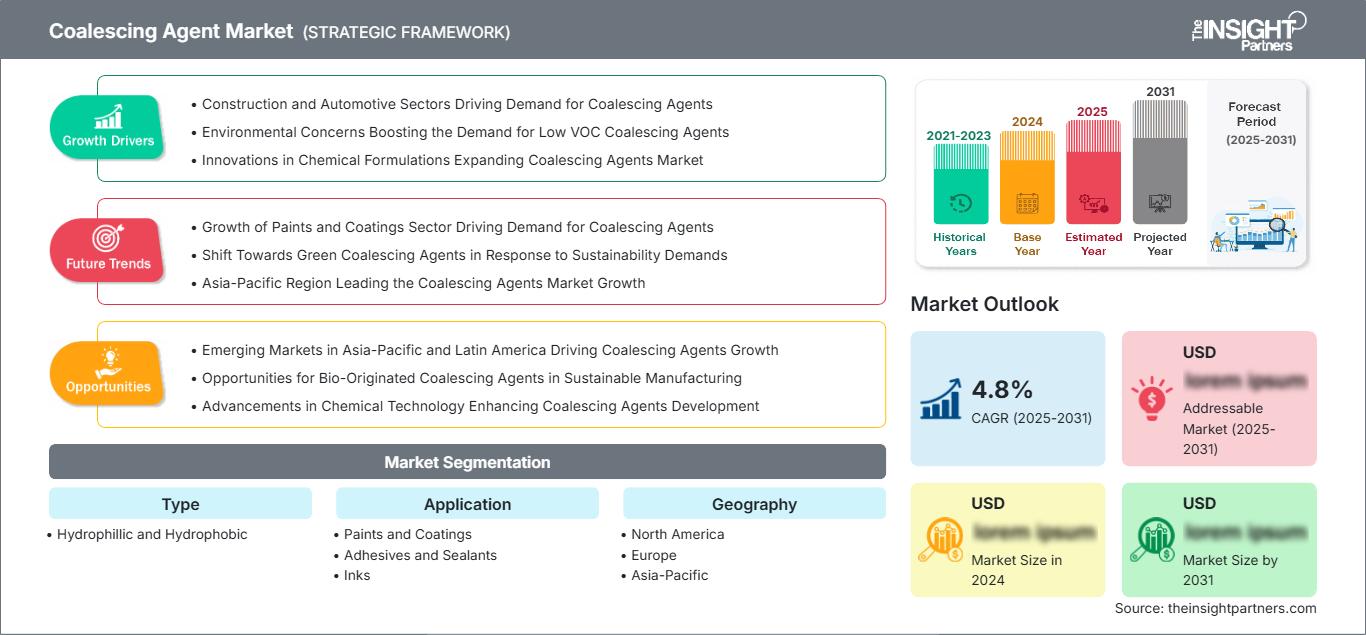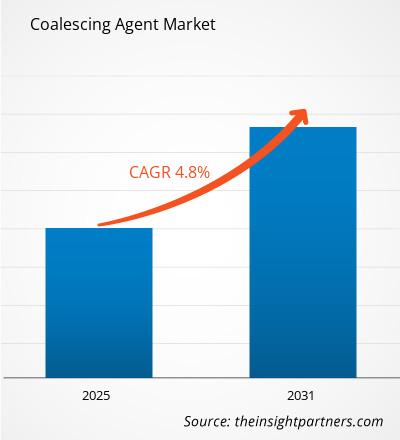Se espera que el mercado de agentes coalescentes registre una CAGR del 4,8 % entre 2025 y 2031, con un tamaño de mercado que se expandirá de US$ XX millones en 2024 a US$ XX millones en 2031.
El informe está segmentado por tipo (hidrófilo e hidrófobo). También está segmentado por aplicación (pinturas y recubrimientos, adhesivos y selladores, tintas, cuidado personal, entre otros). El informe abarca cinco regiones: Norteamérica, Europa, Asia Pacífico, Oriente Medio y África, y Sudamérica y Centroamérica, así como los países clave de cada región. El análisis global se desglosa a nivel regional y por países principales. El informe ofrece el valor en USD para el análisis y los segmentos mencionados.
Propósito del Informe
El informe "Mercado de Agentes Coalescentes" de The Insight Partners busca describir el panorama actual y el crecimiento futuro, los principales factores impulsores, los desafíos y las oportunidades. Esto proporcionará información a diversas partes interesadas del negocio, como:
- Proveedores/fabricantes de tecnología: Para comprender la dinámica cambiante del mercado y conocer las oportunidades potenciales de crecimiento, lo que les permitirá tomar decisiones estratégicas informadas.
- Inversores: Realizar un análisis exhaustivo de tendencias respecto a la tasa de crecimiento del mercado, las proyecciones financieras del mercado y las oportunidades que existen en toda la cadena de valor.
- Órganos reguladores: Regular las políticas y las actividades policiales en el mercado con el objetivo de minimizar el abuso, preservar la confianza de los inversores y defender la integridad y estabilidad del mercado.
Segmentación del mercado de agentes coalescentes
Tipo
- Hidrofílico e hidrofóbico
Solicitud
- Pinturas y recubrimientos
- Adhesivos y selladores
- Tintas
- Cuidado personal
Obtendrá personalización en cualquier informe, sin cargo, incluidas partes de este informe o análisis a nivel de país, paquete de datos de Excel, así como también grandes ofertas y descuentos para empresas emergentes y universidades.
Mercado de agentes coalescentes: perspectivas estratégicas

-
Obtenga las principales tendencias clave del mercado de este informe.Esta muestra GRATUITA incluirá análisis de datos, desde tendencias del mercado hasta estimaciones y pronósticos.
Factores que impulsan el crecimiento del mercado de agentes coalescentes
- Los sectores de la construcción y la automoción impulsan la demanda de agentes coalescentes: El auge de los sectores de la construcción y la automoción está incrementando la demanda de agentes coalescentes en recubrimientos y pinturas. Estos agentes facilitan el proceso de decoración, mejoran las características funcionales y la durabilidad, por lo que son cruciales para obtener un buen acabado. Además, existe una demanda cada vez mayor de sistemas de recubrimiento avanzados, ya que se realizan obras estructurales en todo el mundo.
- Preocupaciones ambientales que impulsan la demanda de agentes coalescentes con bajo contenido de COV: El aumento de las preocupaciones ambientales que regulan el funcionamiento normal de las empresas de construcción crea un nicho de mercado para estos productos ecológicos. El desafío radica en que, gracias a los agentes coalescentes con bajo contenido de COV, las empresas pueden mantener su enfoque de sostenibilidad sin incumplir las expectativas de los estándares de rendimiento. Esta transición hacia opciones más ecológicas tiene un impacto positivo en el mercado y en el crecimiento del mercado de agentes coalescentes.
- Innovaciones en formulaciones químicas que expanden el mercado de agentes coalescentes: Las innovaciones en formulaciones químicas aumentarán la eficiencia de los agentes coalescentes y, con ello, abrirán un abanico de posibilidades en sus aplicaciones. En esta área de negocio, los procesos de investigación e invención se dirigen al diseño de sistemas eficientes de agentes especializados para abordar problemas concretos y mejorar la eficiencia del producto. La evolución tecnológica es otro factor que contribuye al crecimiento del mercado, ya que ayuda a satisfacer las cambiantes demandas de los clientes y la necesidad de una gama más amplia de aplicaciones.
Tendencias futuras del mercado de agentes coalescentes
- El crecimiento del sector de pinturas y recubrimientos impulsa la demanda de agentes coalescentes: A medida que el sector de pinturas y recubrimientos continúa creciendo, también crece la necesidad de agentes coalescentes. Estos agentes son esenciales tanto para facilitar la formación de películas como para mejorar el rendimiento de los recubrimientos. La expansión de las industrias de la construcción y la automoción ha generado una mayor demanda de recubrimientos de alto rendimiento, lo que contribuye significativamente al crecimiento del mercado.
- Cambio hacia agentes coalescentes ecológicos en respuesta a las demandas de sostenibilidad: La sostenibilidad está ganando popularidad, y los fabricantes buscan producir agentes coalescentes ecológicos. Se trata de agentes coalescentes con bajo contenido de COV que cumplen con las estrictas normas de control ambiental. Esta transformación se implementa no solo para cumplir con la legislación, sino también para satisfacer la demanda de los consumidores de productos menos dañinos, lo que resulta en una mayor aceptación en el mercado.
- La región Asia-Pacífico lidera el crecimiento del mercado de agentes coalescentes: Se prevé que, geográficamente, el mercado de agentes coalescentes esté dominado por la región Asia-Pacífico como resultado de la industrialización y la urbanización. Las inversiones en construcción y automoción en países como China e India están aumentando, lo que provoca un incremento en el uso de recubrimientos. Es probable que esta tendencia de crecimiento regional tenga un impacto en la estructura del mercado global.
Oportunidades de mercado de los agentes coalescentes
- Mercados emergentes en Asia-Pacífico y Latinoamérica impulsan el crecimiento de los agentes coalescentes: Se prevé un crecimiento sustancial del mercado de agentes coalescentes en diversas regiones del mundo, especialmente en los países emergentes de Asia-Pacífico y Latinoamérica. La continua industrialización y urbanización en estas regiones está provocando un auge en el uso de materiales de construcción y recubrimientos. Las empresas pueden aprovechar este crecimiento estableciendo plantas de producción y canales de distribución locales para satisfacer la creciente demanda.
- Oportunidades para los agentes coalescentes de origen biológico en la fabricación sostenible: Existe una creciente oportunidad para que los fabricantes produzcan agentes coalescentes de origen biológico. Con el creciente énfasis en la sostenibilidad, la producción de estos sustitutos no contaminantes puede ayudar a atraer a clientes potenciales, además de cumplir con las estrictas políticas vigentes. Esta transición no solo mejora la imagen de la empresa, sino que también genera nuevos mercados que buscan productos de química verde.
- Avances en la tecnología química que impulsan el desarrollo de agentes coalescentes: La tecnología química ha avanzado tanto que ofrece posibilidades para el desarrollo de agentes coalescentes más avanzados y específicos. Gracias al desarrollo de la investigación, las empresas pueden crear productos que atiendan incluso a nichos de mercado, como recubrimientos protectores o materiales de unión. Esto probablemente se traducirá en un aumento de la cuota de mercado y una mayor diferenciación de los productos en el ámbito competitivo.
Perspectivas regionales del mercado de agentes coalescentes
Los analistas de The Insight Partners han explicado detalladamente las tendencias regionales y los factores que influyen en el mercado de agentes coalescentes durante el período de pronóstico. Esta sección también analiza los segmentos y la geografía del mercado de agentes coalescentes en América del Norte, Europa, Asia Pacífico, Oriente Medio y África, y América del Sur y Central.
Alcance del informe de mercado de agentes coalescentes
| Atributo del informe | Detalles |
|---|---|
| Tamaño del mercado en 2024 | US$ XX millones |
| Tamaño del mercado en 2031 | US$ XX millones |
| CAGR global (2025-2031) | 4,8% |
| Datos históricos | 2021-2023 |
| Período de pronóstico | 2025-2031 |
| Segmentos cubiertos |
Por tipo
|
| Regiones y países cubiertos |
América del norte
|
| Líderes del mercado y perfiles de empresas clave |
|
Densidad de actores del mercado de agentes coalescentes: comprensión de su impacto en la dinámica empresarial
El mercado de agentes coalescentes está creciendo rápidamente, impulsado por la creciente demanda del usuario final debido a factores como la evolución de las preferencias de los consumidores, los avances tecnológicos y un mayor conocimiento de los beneficios del producto. A medida que aumenta la demanda, las empresas amplían su oferta, innovan para satisfacer las necesidades de los consumidores y aprovechan las tendencias emergentes, lo que impulsa aún más el crecimiento del mercado.

- Obtenga una descripción general de los principales actores clave del mercado de agentes coalescentes
Puntos clave de venta
- Cobertura integral: el informe cubre de manera integral el análisis de productos, servicios, tipos y usuarios finales del mercado de agentes coalescentes, proporcionando un panorama holístico.
- Análisis de expertos: el informe se compila con base en el conocimiento profundo de expertos y analistas de la industria.
- Información actualizada: El informe asegura relevancia comercial debido a su cobertura de información reciente y tendencias de datos.
- Opciones de personalización: este informe se puede personalizar para satisfacer los requisitos específicos del cliente y adaptarse adecuadamente a las estrategias comerciales.
Por lo tanto, el informe de investigación sobre el mercado de agentes coalescentes puede ayudar a descifrar y comprender el panorama de la industria y sus perspectivas de crecimiento. Si bien existen algunas preocupaciones válidas, las ventajas generales de este informe tienden a superar las desventajas.
- Análisis histórico (2 años), año base, pronóstico (7 años) con CAGR
- Análisis PEST y FODA
- Tamaño del mercado, valor/volumen: global, regional y nacional
- Industria y panorama competitivo
- Conjunto de datos de Excel
Informes recientes
Testimonios
Razón para comprar
- Toma de decisiones informada
- Comprensión de la dinámica del mercado
- Análisis competitivo
- Información sobre clientes
- Pronósticos del mercado
- Mitigación de riesgos
- Planificación estratégica
- Justificación de la inversión
- Identificación de mercados emergentes
- Mejora de las estrategias de marketing
- Impulso de la eficiencia operativa
- Alineación con las tendencias regulatorias






















 Obtenga una muestra gratuita para - Mercado de agentes coalescentes
Obtenga una muestra gratuita para - Mercado de agentes coalescentes